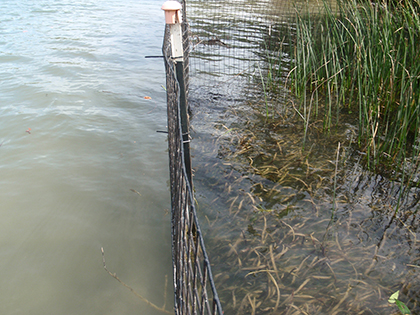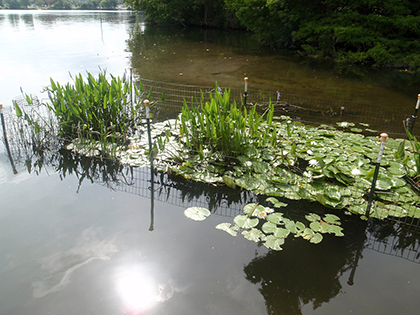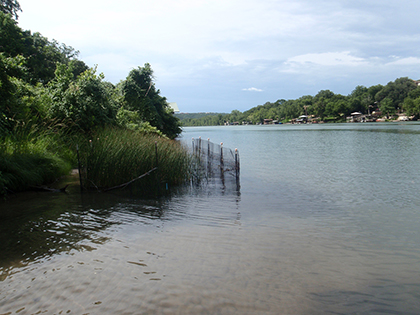The logs you see on the shoreline are made of “Coir” and have been placed with plantings for erosion control and lakeshore habitat.
Coir is the natural fiber found in ripe coconut husks, and it has been used for centuries to make ship ropes due to its durability and resistance to water damage. One of the modern uses for coir includes mats or logs of coir fiber bound by coir ropes for erosion control. Coir is anchored in areas with loose soils that need stabilization including stream banks, wetlands and construction sites. The advantage of using coir logs for erosion control (rather than rocks or bulkheads) is that the coir allows vegetation to grow within it as it slowly biodegrades becoming part of the matrix of the soil. When the coir has finally biodegraded (years later), the roots of the vegetation then provide the long-term stability of the soil which provides natural and beneficial integrity to the land and water.
Although appealing in its low cost, durability and ability to biodegrade, it was unclear if coir logs would be successful in stabilizing the shoreline of Lake Austin due to the intense wave energy from recreational boating. A pilot study to test this method in Lake Austin was initiated in Summer 2009. After 5 years of observation, it was determined that coir logs and plants can be successful (under certain circumstances) in stabilizing and restoring a shoreline to a more natural state. Most coir logs deteriorated slowly and the remaining fiber has roots and stems growing throughout. The pilot study provided valuable information regarding placement, location, timing and plant species.
The Watershed Protection Department has recently installed an additional ~2,000 feet of coir logs and plantings along shorelines managed by the City and County. The sites are currently greatly impacted by erosion and the effort may slow down erosion long enough to develop a resilient vegetation community benefiting both stability, habitat and water quality.
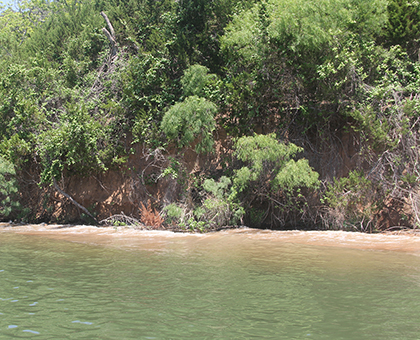
An eroding bank of Lake Austin

Newly placed coir logs and plantings along shoreline
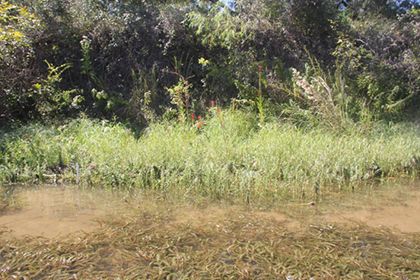
Coir logs and plantings 4 years after installment
Ecosystem services, stated simply, are the benefits humans derive from the environment. Food, clean air and water, fiber for clothes….these are obvious and significant examples of supplies upon which we are dependent. What keeps the water and air clean? How can the land keep providing food to feed billions of people? Why am I happier when out in ‘nature’? Is my home worth more because of its proximity to a resource (e.g., lake, river, park, forest)?
Turns out, the environment is providing more for us then we tend to think about. The myriad processes that occur ‘outside’ give rise to the services we need and desire. Scientists have grouped the activities and products of nature into four categories: First, Provisioning Services. These are the services we are most familiar with (and grateful for) such as food, potable water, wood and fiber, and fuel. Then, we have the Regulating Services. These occur on a scale that may be imperceptible, when things are good, but relate to services very important to us including flood regulation, water purification and quantity, and disease regulation (think Ebola). Those services are still pretty tangible (and relatively easy to monetize). Services for which we have an innate desire are the Cultural Services. These include having a spiritual connection to nature, enjoying the aesthetic quality of the environment, and of course recreational activities (boating, hiking, camping, etc). Probably the most overlooked but important of all the Ecosystem Services provided by nature are what are known as the Supporting Services. The supporting services are the processes and functions of nature that give rise to all the other services listed above. We desire breathable air, plentiful food, and fiber, so we plant trees and shrubs that take up carbon dioxide and provide raw materials and fruits for consumption. Nutrient cycling mediated by plants and microbes help keep our water clean, our food nutritious (high in nutrients and other compounds), and slow climate change. A diverse, species rich landscape full of animals and plants gives us a sense of peace and fulfillment. Without nature and the environment doing what it does through the Supporting Services, we would not have the other services of interest. It is for the protection and sustainability of the environment that the Supporting services are so often studied by scientists and at heart, our regulations and protections are in place (e.g., minimizing nutrient pollution, deforestation, impervious cover). As human populations increase, our footprint on the landscape grows, and our need for ‘natural capital’ becomes greater to support mankind, it will be the protection, regulation, and protection of the Supporting Services that will ensure sustainability of all Ecosystem Services required and desired for the wellbeing of mankind.
The Austin reservoirs are in a constant state of flux. Natural and anthropogenic forces influencing the chemical, biological, and physical characteristics of Lake Austin and Lady Bird Lake include: altered flow regimes dictated by water availability, increased development, and introductions and control of species. Each reservoir is cherished for their aesthetic, recreational, commercial, and municipal benefits. In order to balance the needs of such different users while sustaining an ecologically desirable ecosystem, it is essential to understand the relationship between water chemistry and biological structure of the reservoirs.
One of the most important aspects of reservoir ecosystems influenced by the chemical and biological composition of the system is the flow of energy from primary producers to top consumers. Knowledge of the components of the food web (sources; e.g., aquatic vegetation, phytoplankton) supporting species of interest (consumers; e.g., largemouth bass) is necessary in order to make predictions of potential shifts in community structure that may result from environmental changes and for the implementation of adaptive management strategies ensuring sustainability of desired biological communities. This project aims to collect water and a myriad of potential sources and terminal consumers for measurement of 13C and 15N isotopic signatures.
Stable isotopes are a widely used tool for tracing the flow of nutrients and energy through aquatic ecosystems (Middelburg 2014). Data derived in this study should elucidate the linkages (i.e., source-consumer) and complexity (e.g., trophic levels, number of resources utilized) of the food web, as well as the importance of internal relative to external energy and nutrient inputs to the reservoirs of Austin. Mixing models will be developed to give frequency distributions (i.e., relative contributions) of lower trophic level components in a consumer’s diet (Phillips and Gregg 2003; Phillips et al. 2005). This study will serve to not only describe in quantified detail the current food web structure of the reservoirs, heretofore unknown, but will also serve as a baseline for comparison as the structure of the reservoir’s change under as yet unknown pressures or public desires (e.g., increased vegetation in Lake Austin; increased flows reducing vegetation in Lady Bird Lake).
Plants in aquatic systems are often overlooked as critical components of healthy ecosystems. Aquatic and riparian plants can provide valuable invertebrate, fish and wildlife food and cover, improve water clarity and quality, reduce shoreline erosion and sediment re-suspension, and help prevent spread of nuisance exotic plants. These qualities contribute significantly to ecosystem health and function, which in turn improves the value of the lake as a natural resource.
Inland water bodies in the U.S. include reservoirs, large and small lakes, permanently inundated wetlands, ponds, and riverine systems. Waterbodies exhibiting poor ecosystem health often exist in one of three conditions interrelated to aquatic plants: 1) they completely lack native aquatic plants, 2) they support native plant communities that are insufficient to provide system-wide benefits, or 3) they are infested with nuisance species that cause both environmental and water project use problems.
Because larger aquatic systems (generally greater than 100 acres) are logistically difficult to apply full-scale plantings, the US Army Corps of Engineers – Engineer Research and Development Center ERDC has developed an approach for accelerating the natural process of aquatic plant establishment and spread by utilizing founder colonies. Founder colonies are typically comprised of moderately small (usually less than one acre) plantings made at strategic locations within the waterbody. The principle function of a founder colony is to overcome one of the major impediments to aquatic vegetation establishment: availability of propagules for natural spread. Continual provision of propagules (seeds, fragments, etc.) from founder colonies ensures that they are present when conditions are suitable for natural spread to other areas of a lake. Once established, founder colonies spread in two manners, including vegetative growth from the founder colony itself (e.g., along stolons or rhizomes) and formation of new colonies from fragments, seeds, etc. In addition to supplying propagules, founder colonies provide immediate small-scale (up to 25 acres benefit from each acre of founder colony) habitat improvement in large and intermediate systems. In addition to protecting plants, the structure of enclosures themselves serve as refugia for aquatic organisms such as small fish in waterbodies prone to periodic disturbances (drought, floods, etc.) even when they do not support plants.
In 2016 and 2017, City staff expanded our herbivore exclusion pen installations, putting in large (20' x 50') pens, connecting neighboring pens, and extending pen boundaries to the shoreline. At two sites in Lake Austin we have effectively created vegetation plots each exceeding 4,500 sq ft in size.
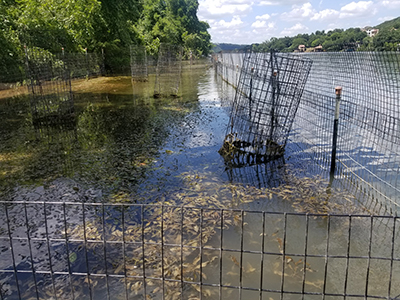
From the approx. 36 one gallon plants originally planted in each pen, we have seen over the past two years a completely expansion and filling-in of the pens with desired, native vegetation. In 2017 we installed a new vegetation pen in Lady Bird Lake. With the return of large discharges through Lady Bird Lake, the native aquatic plant cabomba, which had been prolific in Lady Bird Lake the previous three years, was effectively washed out of the reservoir. In order to re-establish some aquatic vegetation, we installed a new 20' x 50' herbivore exclosure pen just downriver of MoPac. The pen was planted in July and by October was completely filled in with vegetation creating a complex canopy of leaves submersed, floating, and emergent of the water surface.
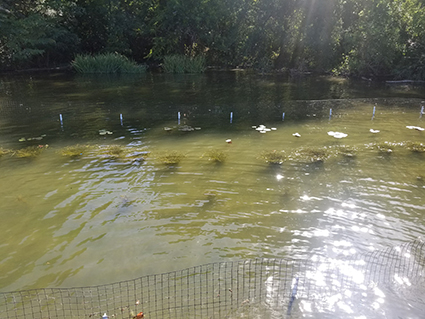
Pen was planted in July 2017.
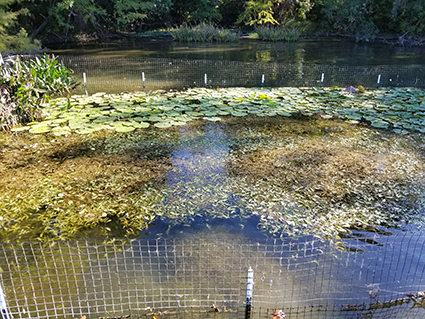
Pen full of vegetation in October 2017.

